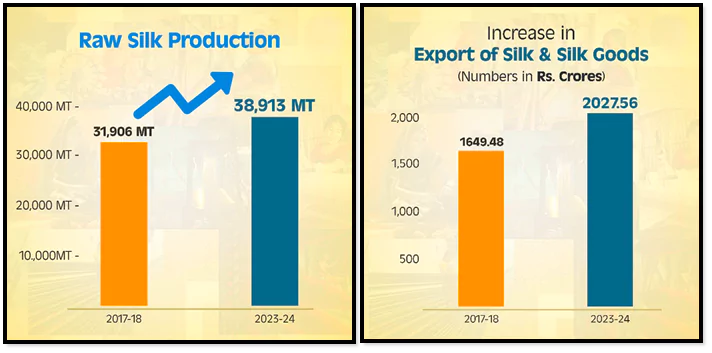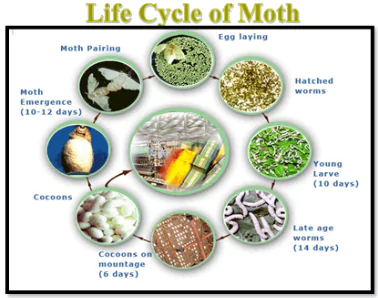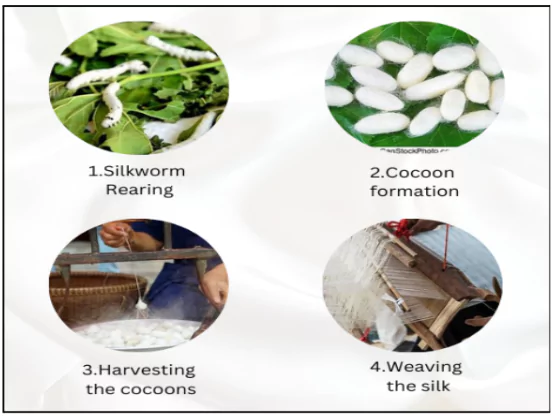In 2023-24, the country produced 38,913 metric tonnes of raw silk and exported silk products worth Rs. 2,027.56 crore, solidifying its position as the world’s second-largest silk producer and top consumer, according to the Ministry of Textiles.
India’s Silk Market
- India’s raw silk production has experienced steady growth, rising from 31,906 MT in 2017-18 to 38,913 MT in 2023-24.
- This growth is supported by the expansion of mulberry plantations from 223,926 ha in 2017-18 to 263,352 ha in 2023-24, which boosted mulberry silk production from 22,066 MT in 2017-18 to 29,892 MT in 2023-24.
- Total raw silk production increased from 31,906 MT in 2017-18 to 38,913 MT in 2023-24.
- Exports of silk and silk goods rose from ₹1,649.48 crores in 2017-18 to ₹2,027.56 crores in 2023-24.
- As per Directorate General of Commercial Intelligence and Statistics (DGCIS) reports, the country exported 3348 MT of silk waste in 2023-24.

About Silk

- Silk is an insect fibre, with lustre, drape and strength.
- Because of these unique features, silk is known as the “Queen of Textiles”, the world over.
- Silk is made of proteins secreted in the fluid state by a caterpillar, popularly known as ‘silkworm’.
- These silkworms feed on the selected food plants and spin cocoons as a ‘protective shell’ to perpetuate the life.
- Lifecycle: Silkworm has four stages in its life cycle: Egg → Larva (Caterpillar) → Pupa → Moth.
-
- Man interferes with this life cycle at the cocoon stage to obtain the silk, a continuous filament of commercial importance, used in weaving of the dream fabric.
Silk Production
- World:
- China is the world’s largest silk producer, accounting for roughly 80% of global production.
- India is the second-largest producer, with about 18% of the global share and 1st in consumption.
- Other significant silk producers include Uzbekistan, Thailand, Vietnam, and Brazil.
- India:
- Karnataka contributed around 32.3% of the total silk production in the country during FY24.
- The other major silk-producing states are Andhra Pradesh, Assam, Bihar, Gujarat, Jammu & Kashmir, Chhattisgarh, Maharashtra, Tamil Nadu, Uttar Pradesh, and West Bengal.
|
Types of Silk
- Mulberry silk: It comes from silkworms that eat only mulberry leaves.
- It is soft, smooth, and shiny with a bright glow, making it perfect for luxury sarees and high-end fabrics.
- 92% of the country’s total raw silk production comes from mulberry. (95% of global silk production).
- Varieties:
- Multivoltine (multiple generations/year) – Higher yield but pest-prone.
- Bivoltine (two generations/year) – Superior quality, preferred for exports.
- Non-mulberry silk (also known as Vanya silk): It comes from wild silkworms that feed on leaves from trees like oak, castor and arjun.
- This silk has a natural, earthy feel with less shine but is strong, durable, and eco-friendly.
- Includes Tussar, Eri, and Muga.
| Types of Silk in India: India is the only country in the world that produces all four major types of silk |
| Type |
Silkworm Species |
Feed Plant |
Main States |
Features |
| Mulberry |
Bombyx mori |
Mulberry leaves |
Karnataka, Andhra Pradesh, Tamil Nadu, West Bengal, J&K |
Soft, shiny, most common (92% share) |
| Tasar |
Antheraea mylitta |
Arjun, Asan |
Jharkhand, Odisha, Chhattisgarh, Maharashtra, WB |
Coarse, coppery, used in furnishings |
| Eri |
Philosamia ricini |
Castor leaves |
Assam, Meghalaya, Bihar, WB, Orissa |
Spun silk, warm, eco-friendly (peace silk) |
| Muga |
Antheraea assamensis |
Som, Sualu |
Assam (exclusive), NE states |
Golden-yellow, glossy, heritage silk |
Origin of Silk
- Ancient Discovery: Silk originated in China over 5,000 years ago.
- Early Use and Development: The Chinese mastered sericulture (silkworm rearing) and weaving techniques, keeping it a state secret for centuries.
- Silk was used in: Royal garments; Religious ceremonies; As currency and diplomatic gifts.
- Spread Beyond China: The secret of silk production remained exclusive to China for ~3,000 years.
- It later spread to:
- Korea and Japan (via migrants and monks)
- India via the Silk Route trade
- Europe much later through Byzantine and Persian interactions
- Silk Road: The Silk Road (a trade network across Asia, Europe, and Africa) was named after this luxurious commodity.
- Silk became a symbol of wealth and diplomacy, contributing to cultural exchange between East and West.
- Silk in India: Evidence of silk use in India dates back to the Harappan civilization (circa 2450–2000 BCE).
- India developed its own indigenous silk traditions (Tasar, Eri, Muga).
- Over time, India became the second-largest silk producer globally and the only country producing all four major types of silk.
What is Sericulture ?
- Sericulture is an agro-based industry.
- It involves rearing of silkworms for the production of raw silk, which is the yarn obtained out of cocoons spun by certain species of insects.
- The major activities of sericulture comprises of food-plant cultivation to feed the silkworms which spin silk cocoons and reeling the cocoons for unwinding the silk filament for value added benefits such as processing and weaving.

Silk Production Process
- Rearing: Silkworms fed on host plants (mulberry, oak, castor).
- Cocoon Formation: Larvae spin cocoons in 3-4 weeks.
- Reeling: Cocoons boiled to extract silk filaments (fibroin + sericin).
- Weaving: Filaments spun into yarn and woven into fabric.
Why Sericulture is Important for India?
- High Employment Potential: Engages 60 lakh people in India, generating 11 man-days per kg of raw silk (on-farm & off-farm).
- Ideal for rural reconstruction, offering year-round work unmatched by other industries.
- Boosts Rural Economy: 57% of silk fabric value flows back to villages.
- Revitalizes village economies by redistributing urban wealth to rural areas.
- Low Investment, High Returns: Requires only ₹12,000–15,000/acre (excluding land cost).
- Quick returns: Mulberry grows in 6 months and sustains rearing for 15–20 years.
- Annual income: Up to ₹30,000/acre with proper practices.
- Women Empowerment: 60% of workers are women, dominating mulberry farming, rearing, reeling, and weaving.
- Flexible, home-based work enhances female participation in rural livelihoods.
- Supports Weaker Sections: Suitable for small/marginal farmers and landless laborers (e.g., tribals in tasar silk).
- Family of three can sustain on 1 acre without hired labor.
- Eco-Friendly Practice
- Soil conservation: Mulberry’s deep roots prevent erosion.
- Waste recycling: Silkworm waste enriches soil; dried twigs replace firewood.
- Low carbon footprint: Minimal machinery use reduces pollution.
- Satisfies Equity Concerns: Transfers money from urban elites (silk buyers) to rural poor (farmers/weavers).
- Landless workers benefit through contracted mulberry farming.
- Utilizes Untapped Potential: Only 0.1% of India’s arable land is under mulberry cultivation — indicating huge scope for expansion.
- Forest-based Vanya silks (Tasar, Eri, Muga) can augment tribal incomes without damaging forests.
Government Schemes in Silk Development
- Silk Samagra Scheme: It is an important Central Sector Scheme, during the year (2017-20) to improve the sericulture industry across India.
- Implementation: implemented by Central Silk Board under Ministry of Textiles
- Objective: To scale up production by improving the quality and productivity and to empower downtrodden, poor & backward families through various activities of sericulture in the country.
- The scheme comprises four (4) major Components:
- Research & Development, Training, Transfer of Technology and I.T. Initiatives,
- Seed Organizations,
- Coordination and Market Development and
- Quality Certification Systems (QCS) / Export Brand Promotion and Technology Up-gradation.
- Silk Samagra-2: It is an extension of this effort with a budget of Rs. 4,679.85 crore for the period 2021-22 to 2025-26. These interventions help improve the entire silk production process, from raising silkworms to producing quality silk fabrics.
- So far, Rs. 1,075.58 crore has been provided in central assistance, benefiting over 78,000 people.
- Financial support has been given to Andhra Pradesh (Rs. 72.50 crore) and Telangana (Rs. 40.66 crore) for the last three years to help with Silk Samagra-2 components.
- Raw Material Supply Scheme (RMSS): The Yarn Supply Scheme (YSS) with partial modification and renamed as Raw Material Supply Scheme (RMSS) has been approved for implementation during the period from 2021-22 to 2025-26.
-
- To make available quality yarn & their blends to the eligible Handloom weavers at subsidized rates.
- Total 340 lakh kg of yarn has been supplied during financial year 2023-2024 under the Scheme.
- National Handloom Development Programme (NHDP): The National Handloom Development Programme (NHDP), running from 2021-22 to 2025-26
- Aim: To support weavers in the handloom sector, including silk fabric producers.
- The scheme takes a need-based approach to foster the integrated development of handlooms and improve the welfare of handloom weavers.
- It provides support for raw materials, design, technology upgrades, and marketing through exhibitions.
- It helps create permanent infrastructure like Urban Haats and marketing complexes, benefiting weavers both within cooperatives and in Self-Help Groups.
- Scheme for Capacity Building in Textile Sector Scheme (SAMARTH): Launched by the Ministry of Textiles, it is a demand-driven and placement-oriented program.
- Extended for 2 years (FY 2024-25 & 2025-26) with a budget of Rs. 495 crore to train 3 lakh people.
- Scheme focuses on entry-level training, as well as upskilling and reskilling in Apparel & Garmenting, handloom, handicraft, silk, and jute.
Governing Body For Silk in India
- Central Silk Board (CSB):
- The Central Silk Board (CSB) is a statutory body under the Ministry of Textiles, Government of India, established in 1948
- Objective: To promote the development of sericulture and the silk industry in the country.
- It is headquartered in Bengaluru.
- The CSB focuses on improving silk production, quality, and promoting Indian silk in domestic and international markets.
- Indian Silk Export Promotion Council (ISEPC):
- The Indian Silk Export Promotion Council (ISEPC) was formed in 1983.
- It is sponsored by the Ministry of Textiles and supported by the Ministry of Commerce, Government of India.
- The ISEPC is an apex and non-profit making body of the Textile exporters, manufacturers and merchandisers.
|
Challenges in Sericulture in India
- Fragmented Land Holdings: Majority of sericulture farmers are small or marginal, limiting scalability.
- Sericulture can be practiced on just one acre, but low land availability restricts commercial potential and technology adoption.
- Heavy Dependence on Weather and Season: Silkworms are highly vulnerable to temperature fluctuations, humidity, and diseases like Pebrine (caused by microsporidia).
- Seasonal variations impact silkworm breeding cycles.
- Dependence on Chinese Imports: In 2015, India imposed anti-dumping duty ($1.85/kg) on Chinese silk to protect local producers.
- Chinese silk meets 15-20% of India’s demand.
- Lack of Organized Market for Vanya Silk: Tasar, Muga, and Eri cocoons are often sold through middlemen (Mahajans), leading to exploitation of producers.
- Absence of a robust marketing system like that for mulberry silk; only partial success of state federations and NGOs in addressing this.
- Technological Gaps and Outdated Practices: Limited access to modern rearing equipment, automatic reeling machines, and design innovations in many regions.
- Silk Samagra introduced Automatic Reeling Machines (ARMs) to produce 3A–4A grade silk, but penetration remains low in remote areas.
- Low Productivity Compared to Global Standards: India lags in silk yield per hectare and cocoon productivity.
- Despite 29,892 MT of mulberry silk in 2023-24, productivity is still lower than in countries like China, the global leader.
- Limited Expansion Despite Huge Potential: Only 0.1% of India’s arable land is under mulberry cultivation, indicating underutilization of resources.
- Upland, wasteland, and forest-based rearing (Tasar) could be expanded to uplift tribal livelihoods, but remain largely untapped.
Way Forward for Sericulture in India
- Strengthen Market Linkages for Vanya Silks: Create organized marketing systems for Tasar, Eri, and Muga through State Federations, TRIFED, and Vanya Silk Market Promotion Cell (VSMPC).
- Promote direct-to-consumer platforms, Vanya Silk Shoppees, and e-marketing portals to reduce dependency on middlemen (Mahajans).
- Expand Mulberry and Non-Mulberry Cultivation: Utilize unused uplands, hill slopes, and watershed areas for mulberry and forest-based food plants for Tasar.
- Encourage intercropping and promote silkworm rearing in tribal and rain-fed areas using government schemes like MGNREGA and RKVY.
- Enhance Technological Adoption: Scale up access to Automatic Reeling Machines (ARMs) and improved chawki rearing centres under Silk Samagra-2.
- Provide training in modern techniques via SAMARTH and other skilling programs, especially for women and youth.
- Strengthen Producer Cooperatives: Foster cooperative models and self-help groups (as seen in Kanchipuram) to enhance bargaining power and reduce exploitation.
- Encourage community-based rearing, seed production units, and collective processing centers.
- Promote Sustainable and Eco-Friendly Practices: Highlight eco-benefits of mulberry (soil conservation, green cover) and encourage organic sericulture.
- Encourage recycling of silkworm waste as garden compost and dried twigs as fuel.
- Support Research & Development: Invest in R&D to develop climate-resilient silkworm breeds and disease-resistant plantations.
Conclusion
India’s silk industry is a blend of tradition and economic growth, supported by government schemes like Silk Samagra. Focus on skill development, quality improvement, and market expansion can enhance India’s global silk trade position while preserving cultural heritage.
![]() 15 Apr 2025
15 Apr 2025




